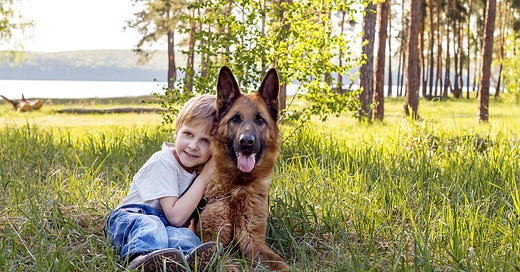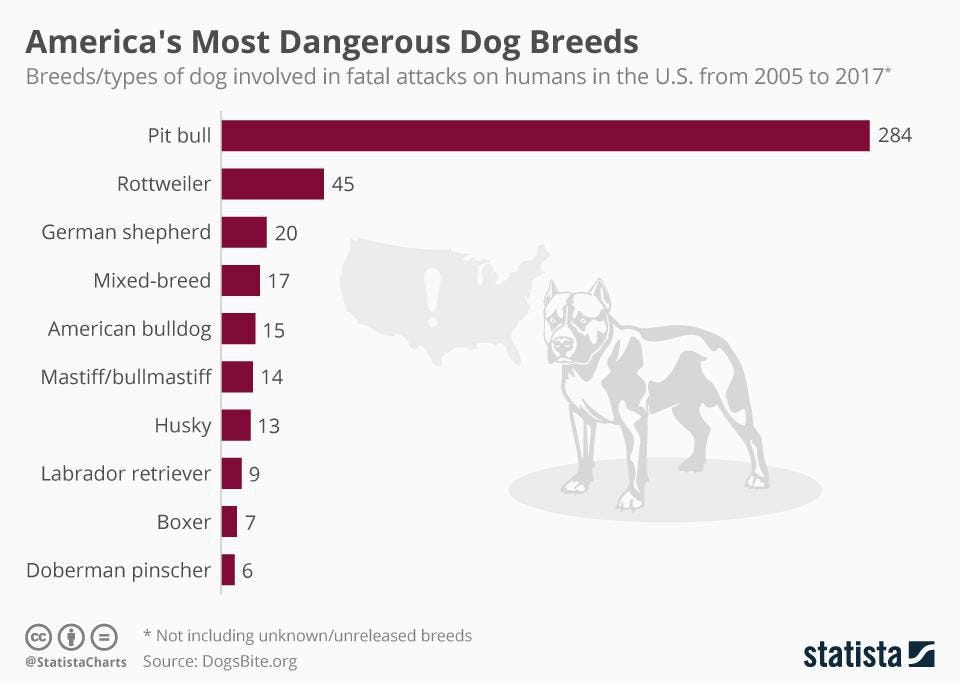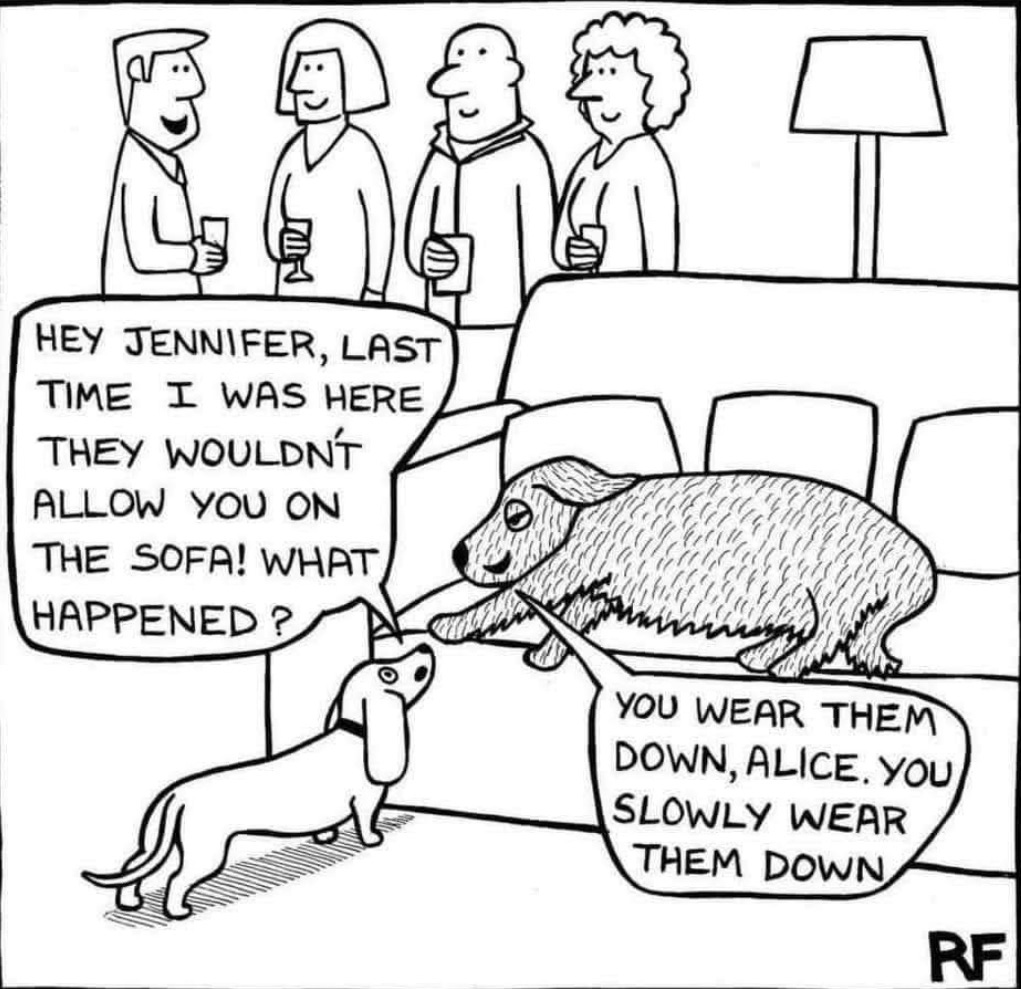UPDATED: May 18, 2025
Welcome to the Healthy Living Is Good Medicine Newsletter, a totally free, health education publication covering a wide variety of topics, with original articles intended to help people lead healthier and more fulfilling lives.
Dangerous Large Animals
In North America, there are only a tiny number of people who are bitten by mountain lions, bears, or sharks, but those incidents invariably receive a lot more attention in the media than a much more common problem.
There are nearly 90 million dogs estimated to be living in the United States. This number is significantly greater than that of previous years, with a steady increase in the dog population taking place from 1996 to 2024. Almost all of dogs have teeth and are therefore capable of inflicting injuries. The larger and more aggressive a dog is, the more severe are those injuries.
With so many dogs, it is not surprising that more than 4.7 million people are bitten each year. However, unless it was a beloved rural letter carrier who is mauled to death by an at-large pack of vicious dogs while making her deliveries, we will likely never hear about it.
It’s Complicated
The relationship between humans and dogs is long and complicated. For the ancient Egyptians, the dog-god Anubis, depicted as a black dog or jackal-headed man, was in charge of protecting the dead and guiding souls to the afterlife. Today, in Europe and America, many humans appear to take the poem about “dog spelled backwards” seriously, and seem to almost worship their pet. In other parts of the world, dogs are raised as food.
I’m not writing about this subject to make people fear or dislike dogs, but rather to explain what you can do to protect yourself and others from an all-too-common type of injury. Despite presenting the information as an aspect of preventive medicine, I expect that some dog lovers will still take issue with my approach. If that’s the case, I can take comfort in the words of acclaimed author, Stephen King:
“If you expect to succeed as a writer, rudeness should be the second-to-least of your concerns. The least of all should be polite society and what it expects. If you intend to write as truthfully as you can, your days as a member of polite society are numbered, anyway.”
Once Bitten, Twice Shy
This old idiom is thought to have its origins in Aesop's Fables, which were based on folk proverbs dating back to 600 BCE. In 1484, the English printer, William Caxton, published a translation of Aesop's Fables, and the saying found its way into our language.
On a personal note, I’ve been attacked by large, off-leash dogs a few times in my life, and to say the least, those were traumatic experiences. I now take precautions, and intend to do my best to avoid becoming a chew toy.
Mind you, I have nothing against dogs that are well trained and under the control of people who understand that not everyone loves their dog as much as they do. Even if a dog is on a leash, if it pokes its nose into my crotch, as far as I’m concerned it is committing sexual assault by proxy, and I do not take kindly to that.
Before I was a parent, I couldn’t go for very long without having one or two dogs in my home. My all-time favorite was a highly intelligent English Springer Spaniel named Dustin, who I referred to as “My little boy in a dog suit.” It truly amazed me how he often seemed able to read my mind. But, I digress….
The Scope of the Problem
Dog bite injuries represent a significant public health concern in the United States. The American Veterinary Medical Association’s 2001 report presents a very disturbing picture, and according to 1994 data from the CDC, around a thousand people are treated in hospital emergency departments across the country every single day for dog bite injuries. Considering the increase in human population and dramatic rise in dog ownership since that report wa published, the number of people injured by dog bites would likely be much higher today.
About 20 percent of dog bites become infected with bacteria such as Pasteurella, Staphylococcus, and Streptococcus. Amputations can result from both infections and direct tissue damage. About 20,000 people a year require reconstructive surgery following dog bites. Homeowners' insurance in the U.S. paid out over a billion dollars in liability claims related to dog bites and other dog-related injuries in 2023.
Risk Factors
Dog bite injuries disproportionately affect children and people living in lower socioeconomic communities. At least half of all dog-bite victims in the U.S. are children, and five to nine year olds have the highest rate of dog-bite injuries. Unsupervised interactions between children and dogs create an elevated risk. Children who are dog-bite victims may develop an intense fear of dogs, or display PTSD symptoms and other adverse psychological effects.
The majority of dog bites occur in a people’s homes. Four out of five bites come from dogs familiar to the victim. Dogs that haven’t been neutered are more likely to bite. Adults with two or more dogs in their household are five times more likely to be bitten than those without dogs.
Prudence around any unfamiliar dogs is clearly justified. Prevention programs focusing on responsible pet ownership, proper pet training, and owner education about dog behavior have been shown to reduce dog bite incidence when implemented effectively.
The Familiar Culprits
Out of many millions of pet dogs in America, in 2017 a majority of dog bites were inflicted by Labrador retrievers. Although they tend to be protective of their families, they are not especially aggressive. It’s their sheer numbers that skewed those statistics. Similar statistics implicated the highly popular Cocker Spaniels of Great Britain. Let's face it; breed aside, almost any dog can bite you hard enough to draw blood.
Major Injuries and Deaths
American pit bull terriers and their mixes with other breeds are the most commonly identified dogs responsible for causing major injuries and deaths. Of the 58 U.S. dog bite fatalities recorded in 2023, 65 percent involved pit bulls and their mixes. That is a significant increase over previous years, and suggests a disturbing trend. Pack attacks accounted for 29 percent of all fatalities, and off-property attacks were involved in 43 percent of those fatal dog encounters.
Bred for Biting
Dogs have been selectively bred for fighting, guarding property, catching fleeing suspects, and intimidating prisoners. Law enforcement and the military utilize canine (“K-9”) contingents. Some breeds, popularized by the Nazis, were savagely employed by concentration camps guards. Today, pit bulls are the favorites of paroled felons, who are prohibited from possessing other kinds of deadly weapons. It would be wise to recognize the most dangerous breeds, and do your best to avoid encounters with them.
American Pit Bull Terrier
Staffordshire Terrier
Rottweiler
German Shepherd (Alsatian)
Doberman Pinscher
Belgian Malinois
Akita
Boxer
Protection from Unleashed Dogs
The first rule in self-defense of any kind is to pay careful attention to what's happening around you at all times. A dog can cover a lot of ground very quickly, and if you're looking at your phone instead of your surroundings, your first inkling of trouble could be a dog chomping on your butt. Paying attention buys you time, and having more time gives you more options in choosing your response to the threat.
Never assume that a stranger's dog is friendly, even if their owner says that it is. Unless the dog is directly under the control of a human, or is sound asleep, it presents a potential risk. It is not uncommon for a dog to bite someone, and for their owner to then say something to the effect of, “Oh, he's never done that before. What did you do to provoke him?”
I refer to such people as FIDOs (“Foolishly Irresponsible Dog Owners”).
They don't know diddly-squat about dog training.
They use an extensible leash and let the dog control its length.
They allow their dog to approach other people uninvited.
They let their dog off-leash in violation of city or county ordinances.
They let their dog pee and poop on other people's lawns and gardens.
They don't clean up after their dog.
They leave their dog outside while it barks incessantly.
They think everybody loves dogs, or should.
As TV’s “Dog Whisperer” Cesar Millan has frequently said about so-called “problem dogs,” they are actually the fault of “problem owners” who have failed to assert themselves as being in charge, and have not properly trained their pet. A dog shouldn’t get to do whatever it wants. Owners need to establish clear boundaries and set firm limits.
A dog may indeed be friendly, but that doesn't mean it automatically deserves a friendly response from people who it approaches uninvited. Don’t let yourself be fooled by a wagging tail. When it comes to unfamiliar dogs encroaching upon my personal space, I'm definitely into pandemic-era social distancing, and I don’t act all friendly or welcoming. When their owner calls out, “He’s friendly,” I shout back, “I’m not!”
Need a little levity at this point? Then watch this:
Defensive Strategies
I would caution against petting any unfamiliar dog. However, if the dog belongs to someone that you know and trust, first present the back of your hand for the dog to sniff while making a fist, so that your fingers are not extended. I speak from my secondhand experience, gained by working in the surgical section of a hospital’s emergency department. Salvaging bitten fingers is not an easy job.
Whatever you do, don't turn your back on an approaching dog, and never run away. You can’t outrun a dog, and running can trigger an attack. Remember, their ancestors were wolves that instinctively chased down running prey. If you can, put yourself out of reach by climbing up on something; a fence, a tree, a parked car or truck, or if you have to, the tallest person in your vicinity.
You can try slowly backing away from an aggressive dog while facing it and making soothing sounds, but I've found that a strong offense can be the best defense. Summon your inner “killer ape” and don't show fear. You may not be much bigger, but you certainly are a lot smarter. By assuming the persona of a “Top Dog” or a “King Kong,” I can usually get aggressive dogs to back down, or at least have the encounter end in a standoff until the owner steps in to save their dog from my threatened aggression.
Cowering, averting your eyes, acting submissive, offering a treat, and all the other appeasement strategies suggested on dog-loving social media sites might work for those people who are absolutely incapable of becoming warriors. You have my condolences if that’s you! I believe in standing up to bullies, be they human or canine. As always, your mileage may vary.
Defensive Tools
When I'm out and about on my neighborhood strolls, walking down country roads, hiking in the forest, or jogging on the beach, I prefer to speak softly and carry a big stick. It works far better than a shouted “NO!” or a stomped foot to stop a dog in its tracks. I can back up my bark by showing the dog the stick, and that's often enough to discourage it from making contact. If they continue on to trespass upon my personal space I will initiate contact by gently poking them on the nose with the tip of the stick.
The goal isn't to injure the dog, but rather to discourage it from advancing any further. It's typically the owner (who’s a FIDO) who's to blame for allowing their dog to do what dogs will sometimes do. Please direct the bulk of your ire toward them, not their dog.
Unless you’re a major league baseball player in top form, wildly swinging a cane or walking stick like it’s a bat won't deter attacking dogs, because they can easily dodge it. And, by the way, don't be walking around with a bat, unless you're actually traveling to or from a baseball game. The police tend to frown on that sort of thing, and you could be cited for brandishing a weapon.
A wooden stockman's type of cane can pass as a “medical assistive device” and therefore be legally carried everywhere. With a rubber tip, it can even be taken aboard commercial aircraft, but do check with your specific airline to make sure that you can board with it.
If you don't want to carry a walking stick or stout cane, consider an expandable baton like the kind that animal control officers use, provided that it is legal for civilians to carry where you live. In many jurisdictions, it is not.
In addition to a cane, I carry pepper spray, but not the kind that's intended for dogs. In my experience, if a dog is the least bit intent on closing the distance, pepper sprays such as “Halt” and “Protector” don't work very well as deterrents, and they're not anywhere near bear sprays in their effectiveness. If you’re riding a bike or walking in the countryside where dogs can run at large and form packs, I highly recommend carrying bear spray.
In populated areas, I carry a law enforcement grade pepper-stream sprayer made by Fox Labs or Sabre. However, its main purpose is not to deter dogs, but rather their incensed owner, if they insist upon threatening me for having pushed their dog away with my cane. Believe me, that happens all too often, so I’ve also learned some “cane martial arts” moves, to be even safer.
I discourage anyone who legally carries a firearm from using it against dogs, except as a very last resort. That might be the case if you’re attacked by a pack of dogs in a rural setting. Shooting the alpha dog could quickly end the threat. On the other hand, in an urban or suburban setting, the risk of ricochets and the legal ramifications of discharging a firearm, along with potential animal cruelty charges, generally make guns an unattractive option for dog defense.
When it comes to bladed weapons, a “metallic fang” is much better than your bare teeth for biting back. However, even assuming that you could deploy one in time, knives involve close-quarters battles that will more than likely result in your being mauled. They certainly aren't very effective when wielded against a dog from above, and you will always want to stay on your feet to better protect your face and throat from their attack.
I'll leave it to you to Google “knife vs. dog” and read what the armchair warriors have to say, but I think you’ll generally be wasting your time. An exception might be when a pit bull has latched onto a portion of your anatomy, or that of your canine or human companion, and won't let go. You'd need to severely compromise its respiration and/or circulation for a counter-attack to be effective. So, it might be worth learning some dog anatomy to help you locate the common carotid arteries, found laterally in the neck between the cervical spine and trachea.
Stick with a Stick
Why resort to a weapon that can get you into legal trouble, when a stout cane or walking stick, or even a furled umbrella, can keep most dogs at bay. I've seen a film in which Arctic wildlife biologist, Nikita Ovsyanikov, fended off polar bears with a 10-foot wooden staff. If that strategy works on a hungry top predator intent upon eating people, it should also be effective against most dogs. Speaking from my own, albeit limited experience in deterring off-leash pit bulls, yelling “NO!” and pointing the tip of your walking stick at its nose is likely the most effective way to respond.
If you are walking your own dog, and an off-leash dog attacks it, the situation becomes a lot more complicated. Many people are bitten while trying to protect their pet. Some “experts” recommend a K-9 “break stick” or using a fire extinguisher to make the other dog let go of yours. That’s probably too complicated, or cumbersome. Preventive measures are always preferable, and there are some practical strategies for employing them.
What to Do If Bitten
If all else fails and you are bitten, the incident should be reported to the appropriate authorities in your jurisdiction, usually the sheriff, police, or an animal control officer. Be sure to get the names and contact information of any witnesses, as well as the offending dog’s owner.
If the dog was running at large, its owner will need to be tracked down and cited by law enforcement. The dog might need to be quarantined at the owner's expense to ensure that it doesn't have rabies. Although this potentially fatal disease is rare in the United States due to widespread vaccination and the testing of dogs coming into the country, it still remains a deadly threat, so take all necessary precautions.
Alarmingly, the anti-vax lunacy that exploded during the COVID-19 pandemic, and continues to gain traction under RFK Jr’s reign in Washington, has been extended to pet vaccinations, consequently increasing the risk of canine rabies. A recent study found that more than half of dog owners believe that dog vaccines are unsafe, ineffective, or unnecessary. I’m talking about FIDO again, in yet another guise.
Because of the risk of infection, if bitten you should seek immediate medical attention. There is also a risk of encountering antimicrobial resistance by the bacteria in dog saliva. Injuries should be medically documented, including a photographic record.
Be sure to get a tetanus vaccination if you are not up-to-date. Wounds will need to be properly cleaned and dressed, and you will likely be prescribed antibiotics. Severe injuries should be referred to the appropriate specialist, and patients may need to be hospitalized for intensive treatment with intravenous antibiotics and surgical drainage of their wounds.
In some states, you can sue the dog's owner for damages, but other states have a “first bite” exception to civil actions. If the owner has violated local ordinances, I encourage you to press charges. Hopefully, they will be required to pay fines. Repeat canine offenders present a danger to the community and should be euthanized. I won’t say what I’d like to see done to their FIDOs.
Having raised and trained a lot of well-behaved dogs over the years, I find bad dog behavior inexcusable and unacceptable. You already know how I feel about FIDOs, which is why I say, “Make 'em pay” if their dog bites you. That may be the only way they’ll learn that being a FIDO has real-world consequences.
Now, go forth properly prepared, and be more careful out there.
― ― ―
Posts can be updated at any time. Please check back here again to find the most up-to-date version of this article.
You can find many more articles about Healthy Living in my Post Archive.
I encourage you to share my Website Link with others via your social media accounts. You can help your friends and followers become healthier by suggesting that they subscribe to my totally free Newsletter.








